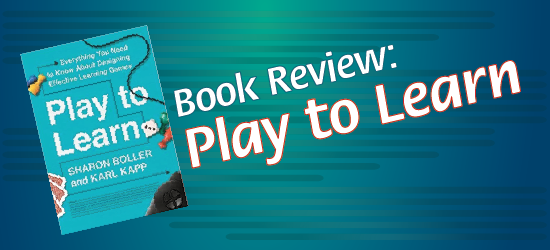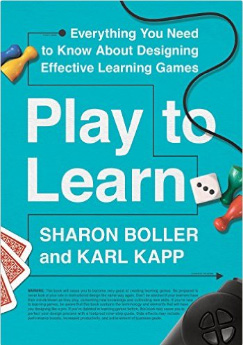
 Think back a mere five years ago. In many circles, games were considered a juvenile pursuit not appropriate for adult learners. Fast forward to today. Games and gamification are an accepted engagement strategy for the workplace.
Think back a mere five years ago. In many circles, games were considered a juvenile pursuit not appropriate for adult learners. Fast forward to today. Games and gamification are an accepted engagement strategy for the workplace.
What’s changed? First, employees are tired of uninspired learning interventions. Second, there is a growing body of research demonstrating that games are more effective than lecture-based approaches to learning. And finally, games are a way to encourage and promote innovative thinking. Ready to get on board?
One of the best ways to jump on this exciting train is through Sharon Boller and Karl Kapp’s book, Play to Learn. The principles covered here relate to learning games, whether they are played on the desktop, a mobile device or in the classroom. In this review, I’ll take you on a trip through the book, so you can see its value for yourself.
First Stop: Playing Games to Learn About Games
If you are a novice or budding game designer, you will appreciate the first section of this book. It provides the terminology, concepts and strategies for thinking about games in a sophisticated way. Boller and Kapp want you to start playing games from a designer’s perspective. They’ll have you evaluate each game as you play. What makes a game compelling? How do you feel when you lose? Do you understand the rules? Do the aesthetics draw you in? Through this type of assessment, you will be ready to better understand learning games, which have a specific instructional outcome.
Second Stop: Making Game Design Choices That Support Learning
As the book moves its focus to learning game design, the authors want to make sure you don’t stray off course. That can happen by accentuating the entertainment value of the game while de-emphasizing the desired learning outcome.
Through the lens of learning game design, the authors walk you through the steps of defining your instructional goal and learning objectives, creating player personas and determining a game’s constraints. Most important, they clearly lay out how to align learning goals with game design, mechanics, theme and story. Two detailed case studies and an in-depth look at scoring round out this section.
Third Stop: Putting Game Design Knowledge to Work
With your learning game design in hand, the next step is prototyping and testing. Prototypes allow someone to try out and test the game play experience. In Play to Learn, Boller and Kapp provide a step-by-step plan for creating a prototype for any type of game—digital or tabletop. They also explain the three phases of game testing and how to collect crucial feedback from players.
Fourth Stop: Development and Implementation
In this section, the book explores how to transform your final game prototype into a digital or physical reality. This part covers the roles of people you may want to have on your game design team. It also summarizes the tools available for creating games, a development methodology and technical concepts. Play to Learn wraps up with how to deploy a game—from logistics to marketing and communication.
Conclusion
Boller and Kapp capture a full workshop in Play to Learn. The book will provide you with direction, support, examples, case studies and inspiration. It will be a reliable companion as you get started on that game you’ve been thinking about.
Find success with online learning with articles, tips and resources delivered to your Inbox once a month.

Connie,
Thanks for your great review. You did a wonderful job of capturing the essence of the book!
Hi Connie,
I’m happy you reviewed this. I’ve been toying with the idea of incorporating game elements into my work for a while. I just didn’t want to sprinkle badges all over my work and call it a day! I need some evidence that game elements could help me make our learners better off than they were. A quick glance at his table of contents and introductory pages on Amazon made me think this book could make the case.
Thanks!
Jay